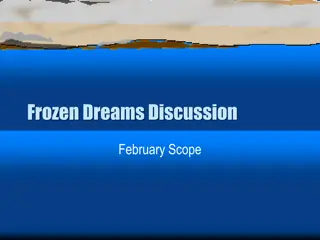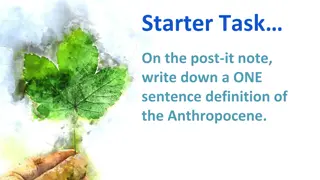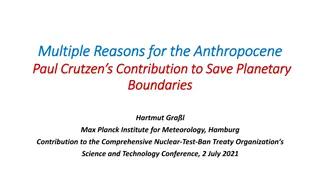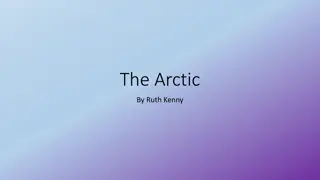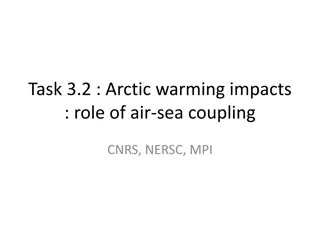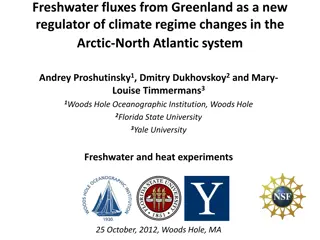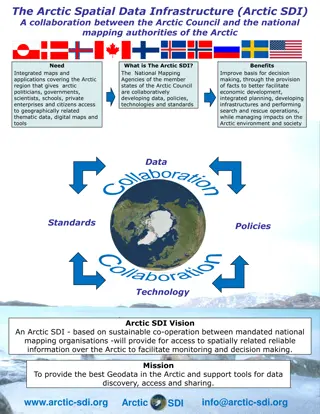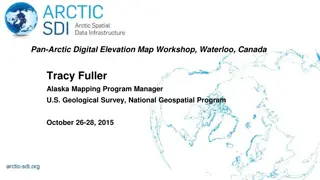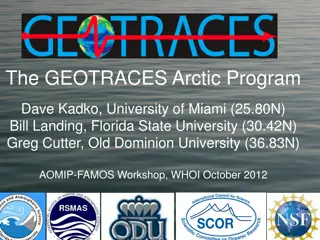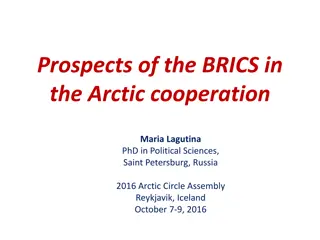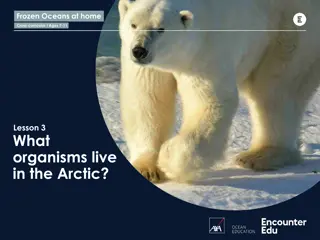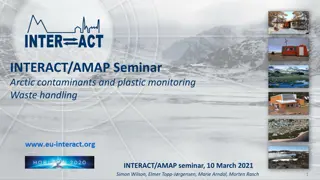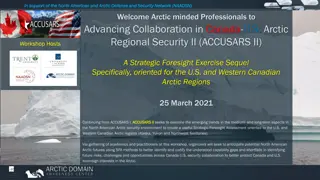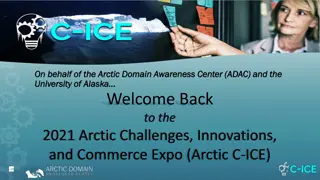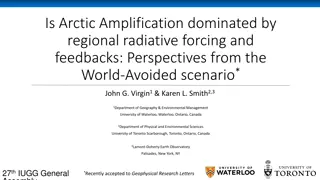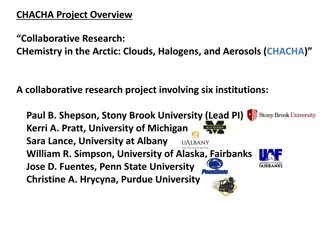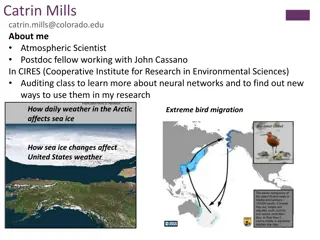The Arctic in the Anthropocene: Emerging Research Questions
The study sponsored by organizations like DOE, NASA, NOAA, NSF, Smithsonian, and USARC delves into the significant implications of Arctic changes on ecosystems, climate, and humanity. The report emphasizes the urgent need for continued research in the Arctic to understand and address the rapid climate change impacting sea ice, permafrost, and ecosystems. Key scientific questions, infrastructural requirements, coordination needs, and research program balancing are outlined for effective decision-making in Arctic research.
Download Presentation

Please find below an Image/Link to download the presentation.
The content on the website is provided AS IS for your information and personal use only. It may not be sold, licensed, or shared on other websites without obtaining consent from the author.If you encounter any issues during the download, it is possible that the publisher has removed the file from their server.
You are allowed to download the files provided on this website for personal or commercial use, subject to the condition that they are used lawfully. All files are the property of their respective owners.
The content on the website is provided AS IS for your information and personal use only. It may not be sold, licensed, or shared on other websites without obtaining consent from the author.
E N D
Presentation Transcript
The Arctic in the Anthropocene Emerging Research Questions Stephanie Pfirman and Henry Huntington Committee Co-Chairs April 28, 2014 Study sponsors: DOE, NASA, NOAA, NSF, Smithsonian, USARC Photo credit: P. Spector
Who are we? National Academy of Sciences (NAS) is a nonprofit organization established in 1863. We were chartered by Congress during the Lincoln Administration to provide independent advice to the Nation on science, engineering, and medicine We are not a government agency. National Academy of Engineering (NAE - est. 1964) and Institute of Medicine (IOM - est. 1970) are connected institutions, expanding our breadth and depth of expertise. (National Research Council is operating arm. ) Intellectual leadership comes from volunteer experts, chosen for expertise, balance, and objectivity. Committee reports are most well known (200+ reports each year) but also research grants, fellowships, workshops, & other uses of independent experts. 2
Committee Membership HENRY HUNTINGTON, Co-Chair The Pew Charitable Trusts STEPHANIE PFIRMAN, Co-Chair Barnard College, Columbia University CARIN ASHJIAN Woods Hole Oceanographic Institution LAURA BOURGEAU-CHAVEZ Michigan Technological University JENNIFER FRANCIS Rutgers University SVEN HAAKANSON University of Washington ROBERT HAWLEY Dartmouth College TAQULIK HEPA North Slope Borough DAVID HIK University of Alberta LARRY HINZMAN University of Alaska, Fairbanks AMANDA LYNCH Brown University A. MICHAEL MACRANDER Shell Alaska GIFFORD MILLER University of Colorado, Boulder KATE MORAN Ocean Networks Canada ELLEN MOSLEY-THOMPSON The Ohio State University SAMUEL MUKASA University of New Hampshire TOM WEINGARTNER University of Alaska, Fairbanks 3
1. Study Context What happens in the Arctic to ecosystems, people, and climate has far-reaching implications for the entire planet Climate change is happening faster in the Arctic than anywhere else on Earth, causing the loss of sea ice, thawing of permafrost, and shifts in ecosystems This report connects the dots between future science opportunities and methods to meet those challenges 4
Charge to the Committee Summarize the rationale for continued U.S. research in the Arctic Identify key emerging scientific questions in different realms of Arctic science (both disciplinary and cross cutting) Photo credit: M. Kennedy Identify the types of research infrastructure, data management, technological developments, and logistical support needed Identify needs and opportunities for improved coordination in Arctic research Explore how agency decision makers might balance their research programs and associated investments 5
Community Engagement Review of published reports and articles (including previous reports from numerous regional, national, and international agencies, organizations, and other institutions ) Online questionnaire (over 300 responses) Targeted interviews (15 researchers) Anchorage Workshop (~50 participants) Ottawa Workshop (~45 participants) Photo credit: P. Spector 6
Community Engagement 9% Respondent Career Stage Graduate student 35% 24% Early career Mid-career Late career 32% Respondent Disciplines Atmosphere/climate Biology/ecology Cryosphere Oceans People/social science Terrestrial/geo Paleo Other/interdisciplinary 10% 22% 18% 3% 12% 6% 12% 17% 7
2. Rationale for Arctic Research Examples of observed impacts of climate change in the Arctic from IPCC 2014 Category Examples Decreasing sea ice cover in summer Reduction in ice volume in glaciers Decreasing snow cover extent Widespread permafrost degradation Increased river discharge for large circumpolar rivers Increased lake water temperatures Disappearance of thermokarst lakes due to permafrost degradation in the low Arctic Increased shrub cover in the tundra Advance of Arctic tree line in latitude and altitude Changed breeding area and population size of subarctic birds Loss of snowbed ecosystems and tussock tundra Increased coastal erosion Negative effects on non-migratory species Snow and Ice Rivers and Lakes Floods and Drought Terrestrial Ecosystems Coastal Erosion and Marine Ecosystems Food Production and Livelihoods Impact on livelihoods of indigenous peoples Increased shipping traffic across Bering Strait 8
3. Emerging Research Questions Existing Questions Those that have been the subject of ongoing research but remain unanswered or for other reasons deserve continued attention Emerging Questions Those that we are only now able to ask because they: Address newly recognized phenomena Build on recent results and insights Can be addressed using newly available technology or access Photo credit: G. Miller 9
Emerging Research Questions Evolving Connected Undetermined Managed Hidden
ERQ: Evolving Arctic Evolving Connected Undetermined Will Arctic communities have greater or lesser influence on their futures? Will the land be wetter or drier and what are the associated implications for surface water, energy balances, and ecosystems? How much of the variability of the Arctic system is linked to ocean circulation? What are the impacts of extreme events in the new ice-reduced system? How will primary productivity change with decreasing sea ice and snow cover? How will species distributions and associated ecosystem structure change with the evolving cryosphere? Managed Hidden Figure source: NOAA 11
ERQ: Hidden Arctic Evolving Connected Undetermined What surprises are hidden within and beneath the ice? What is being irretrievably lost as the Arctic changes? Why does winter matter? What can break or brake glaciers and ice sheets? Managed Hidden How unusual is the current Arctic warmth? What is the role of the Arctic in abrupt change? What has been the Cenozoic evolution of the Arctic Ocean basin? Image source: NASA 12
ERQ: Connected Arctic Evolving Connected Undetermined How will rapid Arctic warming change the jet stream and affect weather patterns in lower latitudes? What is the potential for a trajectory of irreversible loss of Arctic land ice, and how will its impact vary regionally? How will climate change affect exchanges between the Arctic Ocean and sub-polar basins? How will Arctic change affect the long- range transport and persistence of biota? How will changing societal connections between the Arctic and the rest of the world affect Arctic communities? Managed Hidden Image source: NASA 13
ERQ: Managed Arctic Evolving Connected Undetermined How will decreasing populations in rural villages and increasing urbanization affect Arctic peoples and societies? Will local, regional, and international relations in the Arctic move toward cooperation or conflict? How can twenty-first century development in the Arctic occur without compromising the environment or indigenous cultures while still benefitting global and Arctic inhabitants? How can we prepare forecasts and scenarios to meet emerging management needs? What benefits and risks are presented by geoengineering and other large-scale technological interventions to prevent or reduce climate change and associated impacts in the Arctic? Managed Hidden Photo source: USCG 14
ERQ: Undetermined Arctic Evolving Connected Undetermined Managed Hidden Leaving room for new ideas and making it possible to identify new research directions when the need arises requires: Research to better assess new topics Long-term observations to identify changes and surprises without delay Flexibility in funding to be able to move quickly when a significant event occurs. 15
Direct Application/Basic Understanding Short-term Medium-term Long-term application M2: Cooperation/conflict Direct M3: 21st century development M4: Forecasts M5: Geoengineering E1: Community futures M1: Urbanization C1: Jet stream C5: Social connections E4: Arctic extremes H2: What is lost C2: Irreversible ice E2: Wetter or drier H3: Winter H6: Abrupt change H4: Break or brake E5: Primary productivity understanding E6: Species distribution H1: Icy surprises Basic E3: Ocean variability C4: Biota transport H5: Unusual warmth C3: Ocean exchange H7: Cenozoic
Social Science/Natural Science Short-term Medium-term Long-term E1: Community futures Science Social M1: Urbanization C5: Social connections M2: Cooperation/conflict H2: What is lost E4: Arctic extremes M4: Forecasts M5: Geoengineering M3: 21st century development E2: Wetter or drier E5: Primary productivity C1: Jet stream C2: Irreversible ice H6: Abrupt change C4: Biota transport H1: Icy surprises E3: Ocean variability Natural Science H4: Break or brake H5: Unusual warmth E6: Species distribution C3: Ocean exchange H3: Winter H7: Cenozoic
Global/Regional/Local Short-term Medium-term Long-term Global C2: Irreversible ice C3: Ocean exchange H6: Abrupt change H4: Break or brake H1: Icy surprises C1: Jet stream C4: Biota transport M5: Geoengineering E3: Ocean variability Regional E4: Arctic extremes H5: Unusual warmth C5: Social connections E2: Wetter or drier H7: Cenozoic E6: Species distribution M3: 21st century development E5: Primary productivity H3: Winter M1: Urbanization M2: Cooperation/conflict M4: Forecasts Local E1: Community futures H2: What is lost
4. Meeting the Challenges Investment Strategies Human Capacity Cooperation Operations Information Observations
Meeting the Challenges Maintaining and Building Operational Capacity Mobile Platforms Fixed Platforms and Systems Remote Sensing Sensors Power and Communication Models in Prediction, Projection, and ReAnalyses Partnerships with Industry Sustaining Long-Term Observations Rationale for Long-Term Observations Coordinating Long-Term Observation Efforts Photo credit: S. Roberts 20
Meeting the Challenges Enhancing Cooperation Interagency, International, Interdisciplinary, Intersectoral, Social Media Managing and Sharing Information Preserving the Legacy of Research through Data Preservation and Dissemination Creating a Culture of Data Preservation and Sharing Infrastructure to Ensure Data Flows from Observation to Users, Stakeholders, and Archives Data Visualization and Analysis Growing Human Capacity Training Young Scientists Community Engagement Image source: Arctic Collaborative Environment Photo credit: H. Huntington 21
Meeting the Challenges Investing in Research Comprehensive Systems and Synthesis Research Non-Steady-State Research Social Sciences and Human Capacity Stakeholder-Initiated Research International Funding Cooperation Long-Term Observations Photo source: NOAA 22
5. Building Knowledge and Solving Problems Enhance the ways in which we make use of Arctic research Foster collaboration, especially with decision-makers Manage change to the best of our abilities Study what exists, what is emerging, and what awaits us in the Arctic Photo credit: M. Kennedy 23


